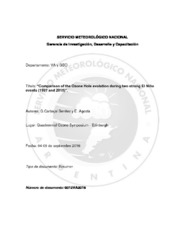Mostrar el registro sencillo del ítem
Comparison of the Ozone Hole evolution during two strong El Niño events (1997 and 2015)
| dc.contributor.author | Carbajal Benítez, Gerardo | |
| dc.contributor.author | Agosta, Eduardo | |
| dc.date.accessioned | 2016-10-24T15:57:41Z | |
| dc.date.available | 2016-10-24T15:57:41Z | |
| dc.date.issued | 2016-09-04 | |
| dc.identifier.uri | http://hdl.handle.net/20.500.12160/76 | |
| dc.description | Resumen de la presentación realizada en el Quadrennial Ozone Symposium, celebrado del 04 al 09 de septiembre de 2016 en la ciudad de Edimburgo, Escocia. | es |
| dc.description.abstract | The stratospheric ozone hole is a recurrent event over Antarctica in early austral spring every year. Its intensity and extent have been showing a recovery trend since 2010. However, the last the ozone hole event has been deeper and larger, comparable to those recorded in the 1980’s. The ozone hole reached an extent of 28.2 million Km2 on Oct 2, being the second biggest one in the last 10 years. Previous works relate El Niño event with Planetary Rossby wave activity in the stratosphere modulating the ozone variability. A very strong El Niño event occurred during early austral spring 2015. Therefore the aim of this paper is to examine the impact of tropospheric Rossby wave activity on the ozone hole evolution during the austral spring 2015 in comparison with the El Niño 1997 that was also another strong event. | es |
| dc.language.iso | eng | es |
| dc.publisher | Servicio Meteorológico Nacional | es |
| dc.subject | AGUJERO DE OZONO - COMPARACIÓN | es |
| dc.subject | AGUJERO DE OZONO - EVOLUCIÓN | es |
| dc.subject | EL NIÑO - 1997 | es |
| dc.subject | EL NIÑO - 2015 | es |
| dc.subject | ANTÁRTIDA | es |
| dc.subject | PRIMAVERA AUSTRAL | es |
| dc.subject | TROPÓSFERA - IMPACTO | es |
| dc.subject | ONDAS DE ROSSBY | es |
| dc.title | Comparison of the Ozone Hole evolution during two strong El Niño events (1997 and 2015) | es |
| dc.type | Other | es |
Ficheros en el ítem
Este ítem aparece en la(s) siguiente(s) colección(ones)
-
Resúmenes [113]
